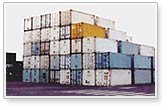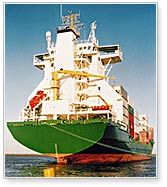|
| |
|
| |
As foreign trade operators we find it difficult to accept answers such as “there is no room,”
“we have exceeded the quota,” “this or that shipping company suspended its regular service,” etc…
HOW MUCH TRUTH IS THERE IN THOSE ANSWERS AND WHAT CAN BE DONE TO SOLVE THE SITUATION?
|
|
|
| |
First, let’s all agree that the lack of hold phenomenon does not happen by chance, it ostentatiously reflects what is known in economy as supply and demand.
How is this phenomenon reflected?, it is really simple: when the hold supply is exceeded by the demand, the prices of the first increase and traders in general pay higher rates until eventually, freights become so expensive that the trader does not obtain any benefit at all for its engagement. This is just one part of the truth, as it does not account for the increased freight price. If we go into greater detail, we will see that one of the factors explaining this situation is the actual hold availability. |
|
| |
 |
When all the vessels and naval devices have been engaged for the transportation of goods – the total hold supply available -, adding new vessels is a process requiring time, for example, the building of new units, which demands an average of 24 months, depending on the type of vessel. It should be added that the shipyards have their complete building capacity engaged until at least 2008, and that last January, building orders had been placed for other fifty-one (51) full-container ships, with a transportation capacity increased by 40% (units suitable for transporting up to 10,000 Teus.)
|
Nevertheless, the shipping companies estimate that the hold demand will continue to exceed the supply, keeping the current upward trend of the freights, though more moderately.
Under these circumstances, the challenge faced by traders is to continue participating and increasing the placing of their products in international markets. Perhaps the time has come to develop other shipment strategies, strategies that can ensure us enough room for our goods in the currently available holds. The foundation for these developments is to get economies of scale big enough to turn the engagement of complete load units (e.g., 20’ containers) into the usual practice.
It is clear that many exporters and importers do not meet the required volume for these operations. Against this backdrop, the operators should naturally resort to the services of large load consolidators, who operate in this market segment (gathering loads from a large number of shippers), and provide them their foreign shipments.
For those who consider these Load Operators as simple middlemen, let’s remember some of the characteristics of these modern transportation companies:
 International representative networks.
 Use of state-of-the-art technologies to track shipments under “door-to-door” conditions.
 Large users of room in maritime, air and ground holds.
 Trained and qualified personnel to understand and assist customers according to their needs.
|
|
 |
Therefore, the advantages obtained by consolidators against those who directly ship their own goods, are mainly focused on their bargaining capacity vis-à-vis carriers in the strict sense of the word.
It is also clear that the consolidators operate within the limitations imposed by the carriers, in other words, if the route –from the service delivery point of view – does not exist, it is useless to expect a satisfactory response. Nevertheless, the Consolidators are so independent from the carriers that, in many cases, they design alternative routes to access unusual destinations and, in that respect, the differences between a Consolidator and a Carrier are so huge that seeing is believing.
|
|
|
|
|
|
|
